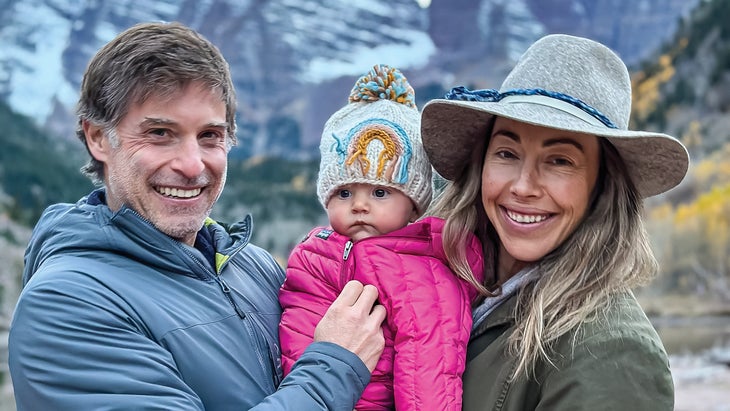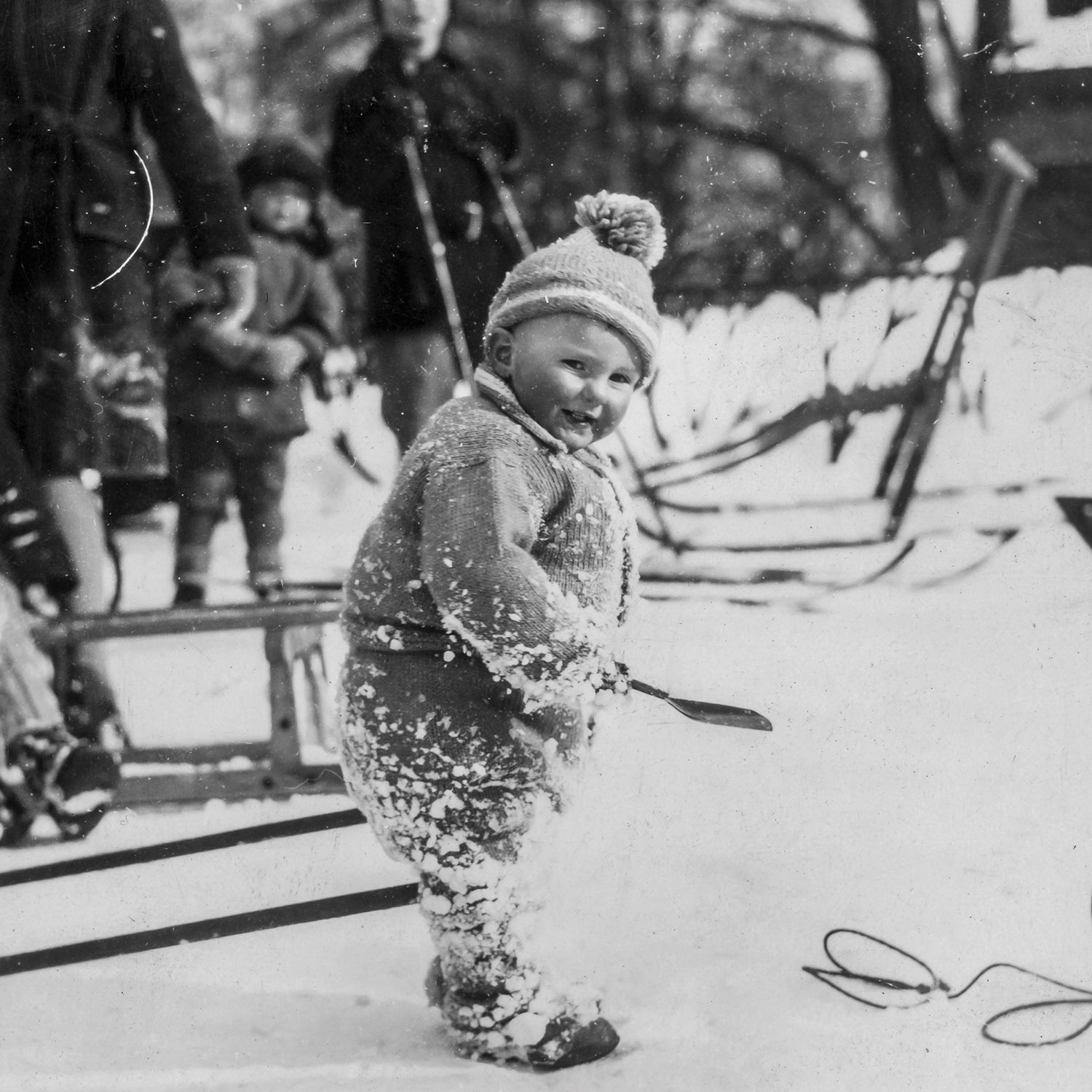Long before the birth of my daughter, Sophie, last spring, I was disillusioned with the American way of parenting. Many of my objections led back to a single overarching theme: we no longer cultivate in our children a healthy relationship with outdoor play.
The problem is familiar: recent studies show that unstructured time outside—referred to as free play, in the words of child development experts—improves mental and physical well-being, yet kids can’t peel themselves away from their tablets and smartphones and Xboxes for more than a few minutes at a stretch. When outdoor activities are present at all, the emphasis is narrowly focused on sport specialization and competitive achievement. Where I live, near Aspen, Colorado, I see kids monitored so closely by parents that any semblance of self-direction or self-reliance is lost. That’s not how I want to raise Sophie. I want her to do her own thing, try a number of activities, and build up the kinds of skills that will enable her to find joy in the outdoors.
In the weeks leading up to her birth, I researched countries that take a different approach to parenting. I came across a 2020 study published in The Lancet, England’s most prominent peer-reviewed medical journal, that identified various mental and physical metrics among children—everything from happiness and life satisfaction to nutrition and health—and ranked countries accordingly. The United States came in 39th. At the top of the list: Norway.
The report raised an obvious question: Why are Norwegian parents doing so much better than Americans are?
As I discovered, access to the outdoors and an appreciation for free play are essential.
My research was helped along by a happy coincidence. Earlier last year, I met a Norwegian-American family named the Lockers who’d recently moved to Aspen. A few months before Sophie was born, I sat down with John and Camilla Locker to get their perspective on Norwegian-style outdoor-centric parenting. John is from New York City; Camilla was born and raised in Oslo. During the pandemic, the family moved to Norway and sent their three-and-a-half-year-old son to a forest school—a preschool that primarily happens outdoors.
“He came home the first day with a whittling knife,” John said. “I was shocked. But they taught him how to use it safely, and soon he was bringing us spoons, bowls, and other things he’d whittled.”
At forest schools, even inclement weather occasions outdoor fun, the Lockers told me. “On rainy days,” Camilla recalled, “they put a big tarp on a hill, covered it in soap, and let the kids slide down.” The children took naps outside in the dead of winter.
“That’s because we wear wool,” said Norwegian Anine Husebye Haug. Haug, 22, was staying with the Lockers for the winter, and she offered anecdotes from her own upbringing. She was shocked by the poor outerwear choices she saw in Colorado. “Americans wear the wrong clothes—synthetics!—so when they’re skiing, they must come in for hot chocolate every two runs. We never come in.” Turns out those heavy woolen sweaters are more than a fashion statement.
Such experiences—attending a forest school, sleeping outdoors in winter—are part of Norwegians’ national identity, which in part is rooted in wilderness capability and resilience. Axel Rosenberg, a lecturer at the Norwegian School of Sport Sciences in Oslo, told me that this trait is captured by the word friluftsliv. (Don’t bother trying to pronounce it.) The term dates back to the late 19th century and was popularized by Roald Amundsen, who in 1911 became the first explorer to reach the South Pole.
“Literally translated, it means ‘open-air life,’ ” Rosenberg said. “It’s how we think about nature, how we relate to nature, and how we integrate nature into our daily lives.”
The term is credited to Henrik Ibsen, who used it in the 1859 poem “On the Heights,” about a farmer’s yearlong trek through the wilderness. Later, around the turn of the 20th century, Norwegians sought to set themselves apart from Denmark—the two countries existed under a unified government until 1814—and friluftsliv helped cement a distinctively Norwegian identity. Amundsen, along with explorers Fridtjof Nansen and Paul Knutsen, built on the tradition with their grueling polar expeditions.
“They credited friluftsliv for opening their world,” Rosenberg said. “The ability to deal with Mother Nature became a benchmark.”
Yet Norwegians weren’t quite as outdoor savvy as they thought. On Easter Sunday in 1967, a group of 15 Norwegians died from exposure while trekking through the mountains, a tragedy that generated headlines across the country. According to Rosenberg, the incident prompted a shift in Norway’s outdoor philosophy, with emphasis placed on skills that keep people safe. The country created the Fjellvettreglene, or , a set of backcountry protocols. Schools began exposing students to nature and emphasizing life lessons that could only be absorbed outdoors.

Norway’s education system embraces trial and error, Rosenberg told me. Kids learn by doing, instead of just being lectured about safety. “By starting at a young age, you find out that nature isn’t dangerous if you stay within your limits,” he said.
When I visited the Lockers, the family emphasized how seriously Norwegian parents take the directive to let kids fail. “There’s no nanny culture, no babysitter culture,” Camilla said. “In Norway, kids roam, and they come home filthy and happy.”
According to this philosophy, children participate in outdoor activities from a young age. Not long after learning to walk, they’re skating around town on plastic skis. They commute to school by bicycle or, in winter, on cross-country skis. Cycling is so important that, at ten years old, kids take a test to ensure they’re competent riding next to cars on the road.
As their skill set grows, Norwegian children not only build an appreciation for the outdoors, they also improve their coordination, endurance, and ability to problem-solve. “Free play—from climbing trees to building forts in the woods—is crucial,” said Kristin Vindhol Evensen, an associate professor at the Norwegian School of Sport Sciences. “The interplay between children and the local environment, which could be playgrounds in an urban environment, or the forest, or mountains in a more rural area, is what creates resilience.”
My assumption was that all the early-age competence would lead to ultracompetitive youth leagues. But Norwegians value play and skills acquisition above competition. In 1987, the country ratified the Children’s Rights in Sport, formal legislation that establishes guidelines for youth sports. Among its main directives is that the primary purpose of sports is to gain skills, make friends, and have fun; there’s nothing about winning. In fact, the guidelines explicitly ban rankings, keeping score, and timed competition before the age of 11. Another mandate: no child is allowed to participate in a championship event until the age of 13.
The guidelines emphasize enjoyment and self-improvement. Haug told me that a favorite kids’ game is to run or ski a one-to-five-kilometer course, then repeat. The goal isn’t to beat your previous time; it’s to lock into the same pace and come as close as you can to repeating it. Having grown up in the world of ski racing, I had to laugh.
“Everything is a game—you’re sort of tricked into learning,” Haug told me. “From a very young age, you’ll put on cross-country skis and play games while wearing them, like tag or capture the flag.” Coaches give pointers, but only to help kids develop. At this stage, winning isn’t the objective.
It’s difficult to argue with the Norwegian formula. Not only does it turn out adults who are physically fit and seemingly well-adjusted, it also produces some of the best athletes in the world. Norway dominated the past two Winter Olympics. In Beijing in 2022, Norway fielded 84 athletes and won 16 gold medals, the most ever by a single nation at a Winter Games. In contrast, the U.S. sent 224 athletes, won eight golds, and totaled 11 fewer medals than Norway. It was an amazing performance by a country with just five million people.
Norway’s sporting prowess is also growing away from the snow. In 2022, Casper Ruud became the first tennis player in the nation’s history to reach the top ten, finishing the year at number three. Triathlete Kristian Blummenfelt is an Olympic gold medalist and Ironman world-record holder; his compatriot Gustav Iden won the Hawaii Ironman in October. Anders Mol and Christian Sørum are the best beach volleyball team on the planet. Jakob Ingebrigtsen is considered one of the world’s best middle-distance runners. And hurdler Karsten Warholm won gold at the 2020 Tokyo Games.
“Being able to play and learn and not worry about competition until you’re older is a big part of why Norwegian athletes are so successful,” said Felix McGrath, a former member of the U.S. Alpine Ski Team. McGrath saw Norway’s system up close: he worked as a ski coach there for 20 years. His wife, Selma Lie, was a member of the national cross-country ski team, and the two raised their four kids in Oslo. McGrath’s son Atle skis for the Norwegian national alpine team and won two World Cup races this past season.
The Norwegian approach has a definite advantage over the competition-crazed American one, McGrath told me. De-emphasizing results in preadolescent kids allows children whose bodies are still developing to thrive. “In the U.S., those kids are beaten, and it’s demoralizing. They end up quitting before they get bigger and stronger and are ready to break through. In Norway, by the time they’re being timed or keeping score, they’ve reached an age where their bodies and minds have matured enough to compete.”
McGrath wondered if Atle would have risen through the ranks in the U.S. system, where kids are identified as talented (or not) very early on, often before they hit puberty.
My conversations with the Lockers, Rosenberg, McGrath, and others were enlightening, but I had my doubts that raising Sophie the Norwegian way was even possible in the States. Our culture doesn’t lend itself to free play and outdoor trial and error. Americans are far more litigious—hence all the helicopter parenting. If Sophie were to fall and break something, my health insurance may make patching her back up challenging and unaffordable.
Still, I believe there are ways I can apply the Norwegian method. Backyard trampolines abound in Norwegian towns and suburbs, and I’m already plotting how to get permission from my homeowners’ association to install one on a patch of community green-space. I’m also rehearsing ways to persuade Sophie to commute by bicycle. I don’t want her to get hurt, of course, but I’m resolved to encourage her to push her boundaries.
“The interplay between children and the local environment, which could be playgrounds in an urban environment or the forest or mountains in a more rural area, is what creates resilience,” said the Norwegian School of Sport Sciences’ Kristin Vindhol Evensen.
Adopting the Norwegian attitude with respect to youth sports will be harder. It’ll be nearly impossible to tell my daughter when she turns 11 that she can’t play in a soccer game because “Dad has a better plan,” even though there are a few examples of this model working in the U.S. Richard Williams, the father of Venus and Serena, famously took his daughters off the tournament circuit when they were ten to help them ease into the game. Ted Ligety, the legendary ski racer who won two Olympic gold medals, recently wrote on Instagram about how much he benefited from recreational skiing with friends after training days. Ligety and his buddies abandoned their competition skis for shaped ones and had fun pushing one another on the same slopes the rest of us ski.
“Without play and experimentation, I would have stayed an OK ski racer and maybe eventually an OK college skier,” he wrote. “But I played and experimented, and it made all the difference.”
The best advice I received was to keep outdoor activities light and fun. Rosenberg told me about another Norwegian tradition called Søndagstur, or “Sunday outing.”
“Norwegians take the family out for the entire day to ski, build a bonfire, and roast hot dogs,” he said. Done, done, and done.


